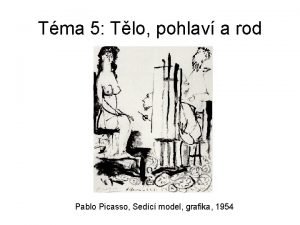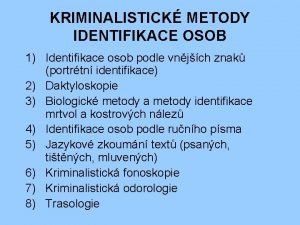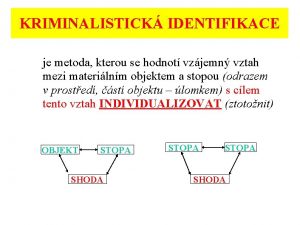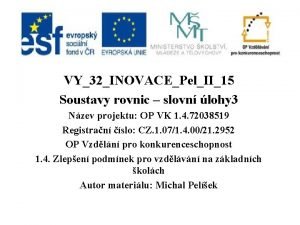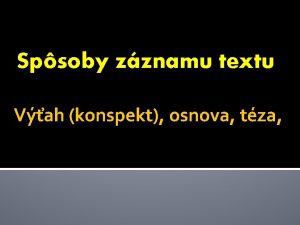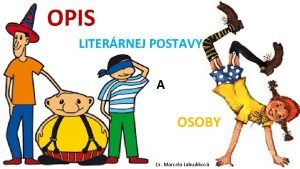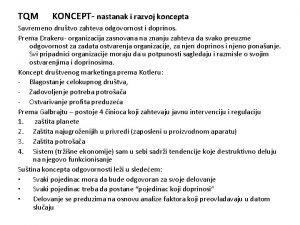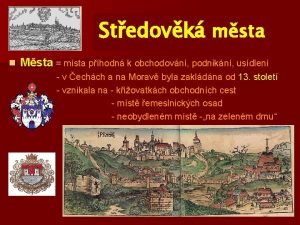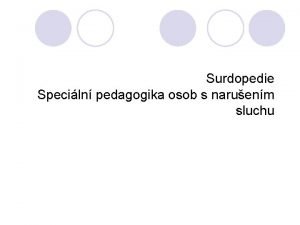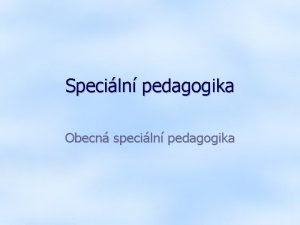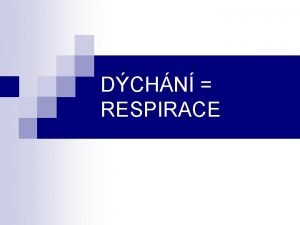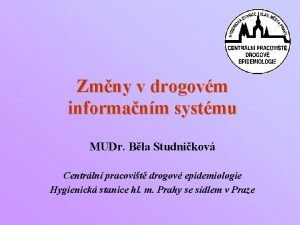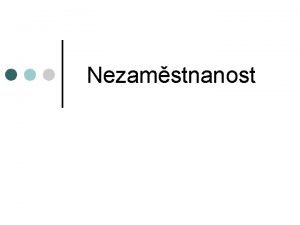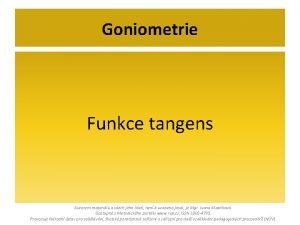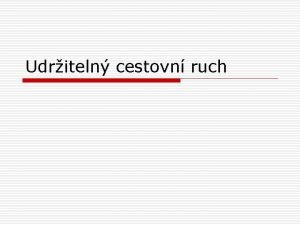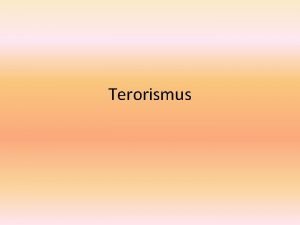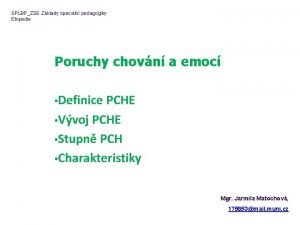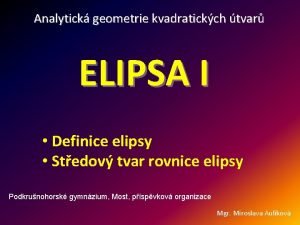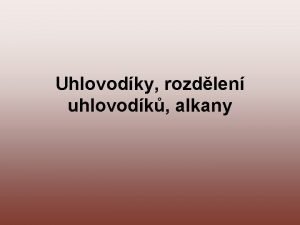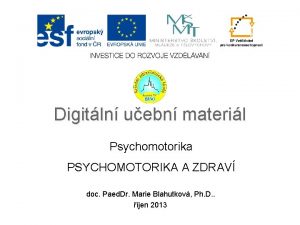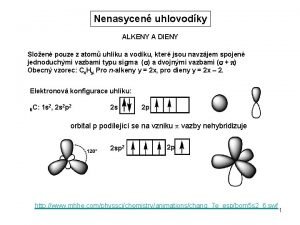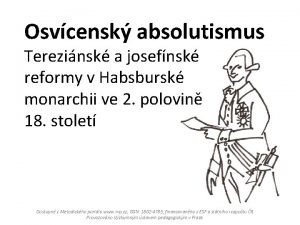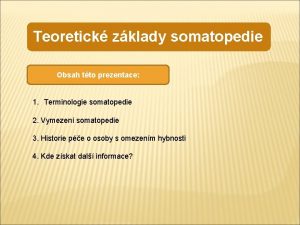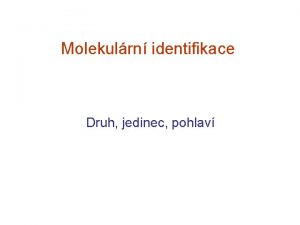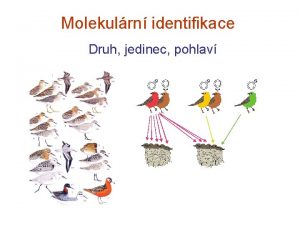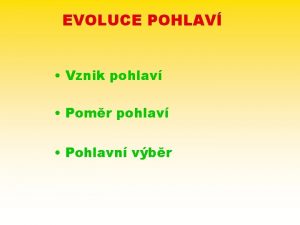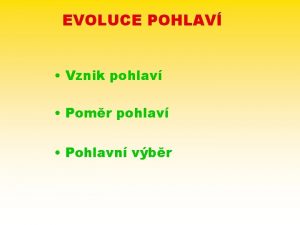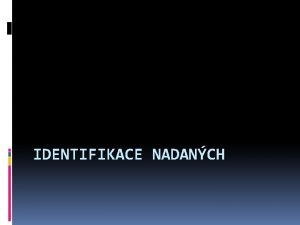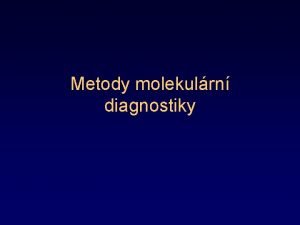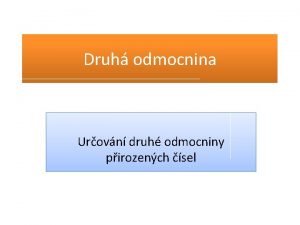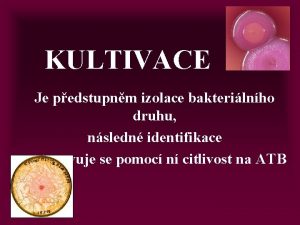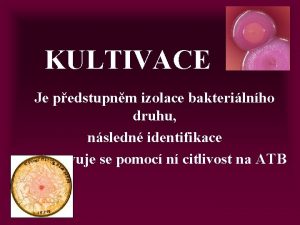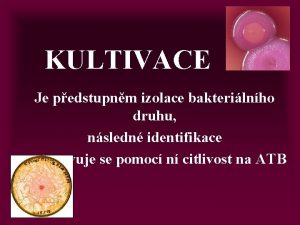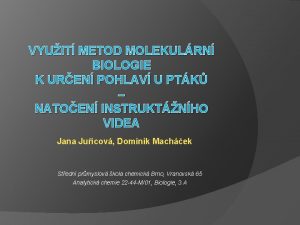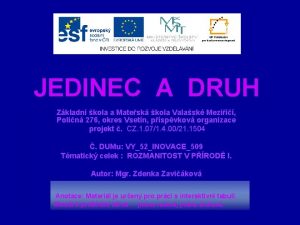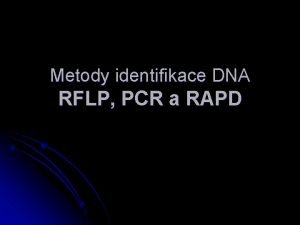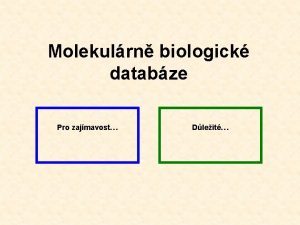Molekulrn identifikace Druh jedinec pohlav Definice druhu Koncept
























































- Slides: 56

Molekulární identifikace Druh, jedinec, pohlaví

Definice druhu • Koncept biologického druhu – RIM = post- nebo prezygotické bariéry toku genů (ne vždy tak jednoduché – hybridní zóny, alopatrická speciace atd. ) • Ochranářská biologie – je nutno rozhodnout o taxonomické jednotce (druhu), která vyžaduje pozornost • Forenzní genetika, vývojová stadia bez determinačních znaků, identifikace kořisti v trávicím traktu predátorů

What is DNA Barcoding? § Definition: Derivation of short DNA sequence(s) that enables species identification or recognition in a particular domain of life (e. g. , eucaryotes). § Barcode of Life Initiative (BOLI) will resolve barcodes for named species and use a barcoding approach to assess undescribed biological diversity.

BARCODING LIFE, ILLUSTRATED Goals, Rationale, Results ppt v 1. 0 March 30, 2005 Mark Stoeckle, The Rockefeller University Paul E. Waggoner, Connecticut Agricultural Experiment Station Jesse H. Ausubel, Alfred P. Sloan Foundation

Barcoding is a standardized approach to identifying plants and animals by minimal sequences of DNA, called DNA barcodes. DNA Barcode: A short DNA sequence, from a uniform locality on the genome, used for identifying species.

Why barcode animal and plant species?

2. What are the benefits of standardization?

Researchers have developed numerous ways to identify species by DNA, typically tailoring the approach to answer a specific question in a limited set of species (e. g. phylogeny). Like convergence on one or a few railroad gauges, barcoding aims to capture the benefits of standardization, which typically lowers costs and lifts reliability, and thus speeds diffusion and use.

• • • Results so far suggest that a mitochondrial gene will enable identification of most animal species. Focus to date: For animals, a 658 base-pair fragment of the mitochondrial gene, cytochrome oxidase subunit I (mt. COI). For plants, mitochondrial genes do not differ sufficiently to distinguish among closely related species. Promising approaches to standardize plant identification use one or possibly more barcode regions are under development.

Why barcode animals with mitochondrial DNA? Mitochondria, energy-producing organelles in plant and animal cells, have their own genome. Twenty years of research have established the utility of mitochondrial DNA sequences in differentiating among closely-related animal species. Four properties make mitochondrial genomes especially suitable for identifying species:

Greater differences among species, on average 5 - to 10 -fold higher in mitochondrial than in nuclear genes. Thus shorter segments distinguish among species, and because shorter, less expensively.

• • • Copy number. There are 100 -10, 000 more copies of mitochondrial than nuclear DNA per cell, making recovery, especially from small or partially degraded samples, easier and cheaper. Relatively few differences within species in most cases. Small intraspecific and large interspecific differences signal distinct genetic boundaries between most species, enabling precise identification with a barcode. Introns, which are non-coding regions interspersed between coding regions of a gene, are absent from mitochondrial DNA of most animal species, making amplification straightforward. Nuclear genes are often interrupted by introns, making amplification difficult or unpredictable.

Cytochrome c oxidase I (COI) contains differences representative of those in other protein-coding genes. Possible gains in accuracy or cost using a different protein-coding gene would likely be small.

What do barcode differences among and within animal species studied so far suggest? • • • Barcodes identify most animal species unambiguously. Approximately 2 -5% of recognized species have shared or overlapping barcodes with closely-related species. Many of the species with overlapping barcodes hybridize regularly. In all groups studied so far, distinct barcode clusters with biologic co-variation suggest cryptic species.

Barcoding North American birds highlights probable cryptic species

Barcodes affirm the unity of the species Homo sapiens. Comparisons show we differ from one another by only 1 or 2 nucleotides out of 648, while we differ from chimpanzees at 60 locations and gorillas at 70 locations.

A barcoder?

Maintaining Credibility Amongst Taxonomic Community Recognizing the intellectual content of taxonomy Demonstrating the utility of DNA barcoding in classical taxonomy problems Integrating DNA barcoding approaches with classical taxonomy and taxonomic methods

Doyen, J. T. and Slobodchikoff, C. N. (1974) An operational approach to species classification. Syst. Zool. 23: 239 -247.

DNA Geography Morphology Reproduction Ecology

What isn’t DNA Barcoding? § It is not intended to, in any way, supplant or invalidate existing taxonomic practice. § It is not DNA taxonomy; it does not equate species identity, formally or informally, with a particular DNA sequence. § It is not intended to duplicate or compete with efforts to resolve deep phylogeny (e. g. , Assembling the Tree of Life, ATOL).

What are the main limits to barcoding encountered so far? • Groups with little sequence diversity • Resolution of recently diverged species • Hybrids • Nuclear pseudogenes

Příklad: Myotis blythii vs. Myotis myotis - introgrese mt. DNA M. myotis - Evropa M. blythii - Asie Berthier et al. 2006

Příklad: Myotis blythii vs. Myotis myotis - introgrese mt. DNA samec M. myotis - Evropa M. blythii - Asie Berthier et al. 2006

Příklad: Myotis blythii vs. Myotis myotis - introgrese mt. DNA M. myotis - Evropa M. blythii - Asie Tendence ke křížení s podobnými hybridy vedla k nárůstu proporce genomu M. blythii v Evropě Berthier et al. 2006

Příklad: Praomys cf. daltoni complex - introgrese mt. DNA Kolik je zde druhů? D Čtyři podle genotypu – cca 7% divergence? -/97/Dva druhy podle fenotypu? 94/100/1. 00 C 2 89/93/1. 00 70/-/96/96/1. 00 98/99/1. 00 C 1 66/77/0. 95 B A 100/1. 00

Clade D Clade A Clade B Clade C 1 Clade C 2 Další komplikace – částečná introgrese mt. DNA z Clade A do Clade C 2 („fosílie hybridizace“¨)

Who is advancing barcoding? CONSORTIUM FOR THE BARCODE OF LIFE (CBOL) is an international initiative devoted to developing DNA barcoding as a global standard in taxonomy. CBOL is a collaboration of natural history museums, herbaria, biological repositories, and biodiversity inventory sites, together with academic and commercial experts in genomics, taxonomy, electronics, and computer science. CBOL has more than 100 institutional members in 40 countries. The inaugural meeting for CBOL was held at The National Museum of Natural History, Washington DC in May 2004. The initial organizational support for CBOL was provided by a 2. 5 year grant from the The Alfred P. Sloan Foundation, renewed in 2006 for 3 years.

Identifikace jedince - metody • DNA fingerprinting (název dnes používán pro různé metody) - velké množství kvalitní DNA - technická náročnost +univerzalita • AFLP - kvalitní nedegradovaná DNA +univerzalita • Sekvenování, alozymy - nemusí rozlišit jedince • Mikrosatelity + stačí malé množství nekvalitní DNA, optimální pro neinvazivní přístupy - je nutné znát konkrétní lokusy a sekvence specifických primerů

Multi-locus genetic markers • Mnoho znaků náhodně rozmístěných v genomu Ø minisatellite DNA fingerprinting (celogenomová RFLP) Ø AFLP (amplified fragment length polymorphism) • presence vs. absence = dominantní znaky (neodliší heterozygota) Př. : chromozóm 1

RFLP (restriction fragments length polymorphism) a AFLP (amplified fragments length polymorphism) • Základem je naštípání DNA restrikčními enzymy • → milióny fragmentů různé délky • Rozdíly díky: – přítomnosti/absenci restrikčních míst – tandemovým opakováním (mikrosatelity, minisatelity) – delece a inzerce • Zviditelnění jen určité části fragmentů

Restrikční endonukleázy Enzyme Site Recognition Restriction site Palindrome • Each enzyme digests (cuts) DNA at a specific sequence = restriction site • Enzymes recognize 4 - or 6 - base pair, palindromic sequences (eg GAATTC) Fragment 1 Fragment 2

Common Restriction Enzymes Eco. RI – Eschericha coli – 5 prime overhang Pstl – Providencia stuartii – 3 prime overhang

Každý jedinec má jedinečný genom Záměna v restrikčním místě = zde ke štěpení nedojde GTAGAATTCACGCA CATCTTAAGTGCGT GTAGAATg. CATTCACGCA CATCTTAc. GTAAGTGCGT 1. Ztráta nebo nabytí restrikčního místa

Každý jedinec má jedinečný genom 2. Ztráta nebo nabytí SINE (např. Alu sekvence) nebo LINE

Každý jedinec má jedinečný genom 3. Vysoká mutační rychlost minisatelitů – rozdíly v počtu repeticí, tj. v délce daného úseku

DNA fingerprinting • Jeffreys et al. 1985 – „naštípání“ DNA pomocí restrikčního enzymu – Rozdělení fragmentů pomocí elektroforézy – Hybridizace (jako sonda minisatelit, např. Alu) • Dostatek kvalitní DNA • Vše na jednom gelu • Laboratorní náročnost Sir Alec Jeffreys

• Naštípání DNA restrikčními enzymy • Navázání adaptérů • Amplifikace primery o nukleotid delšími než je adaptér (jinak sekvence komplementární k adaptéru) • Amplifikace značenými primery o 3 nukleotidy delšími než je adaptér • Detekce – gely, sekvenátor AFLP

Single-locus genetic markers • kodominantní – možno stanovovat frekvence alel • allozymy a jiné funkční geny - MM • mikrosatelity – délkový polymorfismus • SNPs (single nucleotide polymorphisms) – sekvenční polymorfismus • SINE, LINE Př. : chromozóm 1

mikrosatelity • Tandemová opakování krátkých motivů CTTTCTTTCTTTCTTTCTTT • Izolace DNA • PCR CTTTCTTTCTTTCTTTCTTTCTTTCTTTCTTTCTTT • Detekce → sekvenátor, fragmentační analýza kapilára detektor laserový paprsek

Identifikace jedinců závisí na stupni polymorfismu P(ID) • multilocus microsatellite fingerprinting – power estimated as „probability of identity“ (P(ID)) (Waits et al. 2001) Random Sibs Number of loci (H=0. 6) • pilot studies with tissue samples are required to identify P(ID) in a population studied by e. g. Noninvasive methods

Medvědi v Pyrenejích Taberlet et al. 1997 • Trus a chlupy • 24 mikrosatelitových lokusů • 4 samci a jedna samice • Multiple-tube approach, mnohonásobné opakování PCR reakcí (o jednoho víc než podle stop a fotografií)

Lidská forenzní genetika • Pozůstatky vojáků z války Vietnam a Korea Identifikace na základě mt. DNA příbuzných osob (lze jen někdy) V současnosti: vzorek DNA (krve) při odvodu, jiné markery Armed Forces Repository of Specimen Samples for the Identification of Remains • Soudní pře Clinton-Lewinská Pozůstatky ruského cara Nikolaje II • Kriminalistika • Oběti tragických událostí

Klony Bambus Sasa senanensis • Suyama et al. 2000 • Plocha 10 hektarů • AFLP • 22 klonů • Klon na ploše 300 m v průměru

Slavní klonální bezobratlí • Rotifera – Bdelloidea • Ostracoda (Darwinula) • Partenogenetické klony vysokého stáří (milióny let) Darwinula stevensoni

Genetické chiméry • organismy složené z buněk s různými genotypy • Dictyostelium discoideum chimérismus je pravidelná součást života

Genetické chiméry • Ficus srůst kořenů různých jedinců • sumky Botryllus schlosseri chimérické kolonie příbuzní jedinci • Diplosoma listerianum i nepříbuzní

Celleporella hyalina (Bryozoa) Hughes et al. 2004 • Pravděpodobnost fůze koreluje s příbuzností • Histokompatibilita • Lepší rozpoznávání v pokročilejších fázích → dozrávání imunokompetence • Specielní proteiny (spongikany. . . )

Genetické chiméry • kosman bělovousý Callithrix jacchus (asi i Saguinus) • Dizygotická dvojčata • DNA fingerprinting krve • Jsou to hematopoietické chiméry • Během embryonálního vývoje vzájemná výměna buněk kostní dřeně • Týká se to asi jen krve (neinvazivní metody – chlupy, trus →jeden genotyp) • Průnik embryonálních erytroblastů a volné DNA přes placentu u člověka • (pohlaví dítěte před narozením lze určit i pomocí PCR sekvencí typických pro Chr Y, jako templát periferní krev matky)

Genetická identifikace pohlaví 1) druhy s nevýrazným pohlavním dimorfismem (ptáci) 2) zárodky v ranném stádiu ontogeneze (embrya) 3) neinvazivní metody (trus, skořápky, šupiny)

Genetická identifikace pohlaví • druhy s genetickou determinací pohlaví (tj. nejčastěji pohlavní chromozómy) • ptáci (♂=ZZ, ♀=ZW) • savci (♂=XY, ♀=XX) • amplifikace DNA oblasti specifické pro heterogametické pohlaví • W, Y – malé chromozómy

Určení pohlaví – ptáci Griffith et al. 1998 ♂ ♂ ♂ ♀ ♂ • CHD 1 W a CHD 1 Z, geny na pohlavních chromosomech (chromobox-helicase-DNAbinding gene (CHD) – Griffiths & Tiwari 1995) • Primery amplifikují introny obou genů • Introny se mohou lišit délkou • Existují už tři možnosti běžně používaných primerů • Problematické druhy Struthioniformes ♀ ♀

Manorina melanocephala (Meliphagidae) Arnold et al. 2001 • Synové fungují jako pomocníci • U adultů 2, 31 samců na 1 samici medosavka hlučná • Mláďata v hnízdě poměr pohlaví 1: 1 (57: 57) • První se líhnou samci (v 17 hnízdech z 18) Při opouštění hnízda jsou větší a těžší

Určení pohlaví - savci • Amplifikace genu na Chr Y (Sry) (nejlépe duplex PCR s genem na X nebo autosomech) • Sry DNA-binding motif (HMG box) velmi podobný u vačnatců i placentálů • Microtus cabrerae Sry na Chr X Ellobius, Tokudaia Sry zcela chybí • Nannomys Velká variabilita Bryja a Konečný 2003 Nannomys M. cabrerae Ellobius Tokudaia osimensis

Určení pohlaví - savci • Amplifikace genu na Chr Y (Sry) (nejlépe duplex PCR s genem na X nebo autosomech) • Sry DNA-binding motif (HMG box) Bryja a Konečný 2003 velmi podobný u vačnatců i placentálů • Analýzy z trusu: nutno používat druhově specifické markery (jinak cross-amplification s druhy tvořícími potravu) Murphy et al. 2003 x

Určení pohlaví – jiné skupiny • Chr Y občas i u rostlin Rumex • Plazi Calotes versicolor Sry má i 50% samic! • Hledání markerů pomocí nespecifických metod (RAPD, AFLP)
 Pohlav
Pohlav Gonochoristé
Gonochoristé Portrétní identifikace
Portrétní identifikace Kriminalistická identifikace
Kriminalistická identifikace Mocniny do dvaceti
Mocniny do dvaceti Perpetuum mobile prvního druhu
Perpetuum mobile prvního druhu Literárnemu druhu
Literárnemu druhu Ze dvou druhů čaje v ceně
Ze dvou druhů čaje v ceně House koncept
House koncept Konspekt textu
Konspekt textu Black belt utbildning
Black belt utbildning Koncept barok co to
Koncept barok co to Digitalt koncept
Digitalt koncept Charakteristika postavy z knihy
Charakteristika postavy z knihy Tqm koncept
Tqm koncept Phodn
Phodn Definice managementu
Definice managementu Surdopedie definice
Surdopedie definice Definice osobnosti
Definice osobnosti Poměry matematika
Poměry matematika Msp definice
Msp definice Lean management definice
Lean management definice Somatopedie definice
Somatopedie definice Logistika definice
Logistika definice Fotosyntéza definice
Fotosyntéza definice Definice pracoviště
Definice pracoviště Měnový kurz definice
Měnový kurz definice Zaměstnanost definice
Zaměstnanost definice Zbožové peníze definice
Zbožové peníze definice Definiční obor tangens
Definiční obor tangens Udržitelný cestovní ruch definice
Udržitelný cestovní ruch definice Frustrace definice
Frustrace definice Terorismus definice
Terorismus definice Kruhová výseč vzorec
Kruhová výseč vzorec čo je to rodina
čo je to rodina Etopedie definice
Etopedie definice Dezinsekce definice
Dezinsekce definice Fotosyntéza
Fotosyntéza Urputnost definice
Urputnost definice Definice koroze
Definice koroze Osobnost definice
Osobnost definice Středová rovnice elipsy
Středová rovnice elipsy Rodina definice
Rodina definice Alkany definice
Alkany definice Sport definice
Sport definice Definice přídavných jmen
Definice přídavných jmen Elektorát definice
Elektorát definice Sociální pedagogika definice
Sociální pedagogika definice Psychomotorika definice
Psychomotorika definice Co-branding definice
Co-branding definice Fotosyntéza definice
Fotosyntéza definice Funkce obchodu
Funkce obchodu Cyklooktyn
Cyklooktyn Osvícenský absolutismus
Osvícenský absolutismus Kaufland asov
Kaufland asov Somatopedie definice
Somatopedie definice Lyrika definice
Lyrika definice
